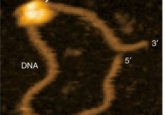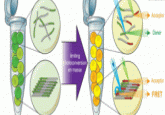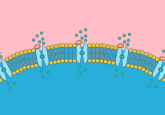Transporting too many proteins overwhelms cells

High demands on protein transport machinery cause cellular growth defects.
Cellular resources are limited—and high protein expression levels can overwhelm these resources and interfere with cell function. In a study published in Scientific Reports, researchers showed that high demands on the transport machinery used to localize proteins to intracellular compartments can also exhaust cellular resources and cause cellular growth defects. According to the authors, insights into the overloading of protein localization processes could be beneficial for cellular engineering and disease treatment.
“We measured the capacities of cellular transport processes for the first time,” said senior study author Hisao Moriya of Okayama University. “This is also the first systematic examination to show high-level expression of localized proteins causes cellular growth defects by overloading protein localization processes.”
Moriya and his team attached amino acid localization sequences, which are used by the cellular transport machinery to direct proteins to different organelles, to green fluorescent proteins (GFPs). Specifically, they used mitochondrial targeting signals (MTS), signal sequences (SS) targeting proteins to the endoplasmic reticulum (ER), nuclear localization signals (NLS), and nuclear export signals (NES).
Using the genetic tug-of-war (gTOW) method they previously developed, the researchers estimated the overexpression limits of signal-modified GFPs in budding yeast cells. In a gTOW experiment, they measured the copy number of an expressed gene and the growth rate of the cells to estimate the level at which protein expression leads to cellular growth defects. On the basis of these measurements, Moriya and colleagues evaluated the overloading of localization resources corresponding to various cellular compartments and analyzed the cellular defects triggered by these loads.
They found that the attachment of localization signals, with the exception of NLS, reduced the copy-number limit of GFP, suggesting that the expression of high levels of proteins with localization signals caused growth defects, just as is the case for misfolded proteins. But surprisingly, the expression levels of GFPs with localization signals were limited to the same degree as toxic misfolded GFPs. High-level expression of SS-GFP induced the ER stress response and led to misfolding, but SS-moxGFP, which avoids misfolding, had the same expression limit as SS-GFP.
“Many researchers believe that overexpression-dependent cellular growth defects are strongly associated with protein functions,” Moriya said. “We however showed that overexpression of any protein beyond the capacities of protein production and protein localization could cause cellular growth defects, which will change the paradigm about the consequences of protein overexpression.”
The researchers also measured the protein expression limits of GFPs with localization signals. Although the limit of GFP was 15% of total protein, the limits of MTS-GFP, NES-GFP, and SS-GFP were 4%, 1%, and 0.7%, respectively. “For cellular engineering, knowing the cellular capacity of protein production in each organelle is important, especially when we want to produce a large amount of proteins within the cell,” Moriya said.
The findings could also have relevance to cancer treatment, given that the simultaneous overexpression of many proteins in cancer cells likely overwhelms the capacity of the transport machinery. “We think that further stress in the transporting processes will specifically kill cancer cells,” Moriya said. “This could be a novel strategy to treat cancer.”





